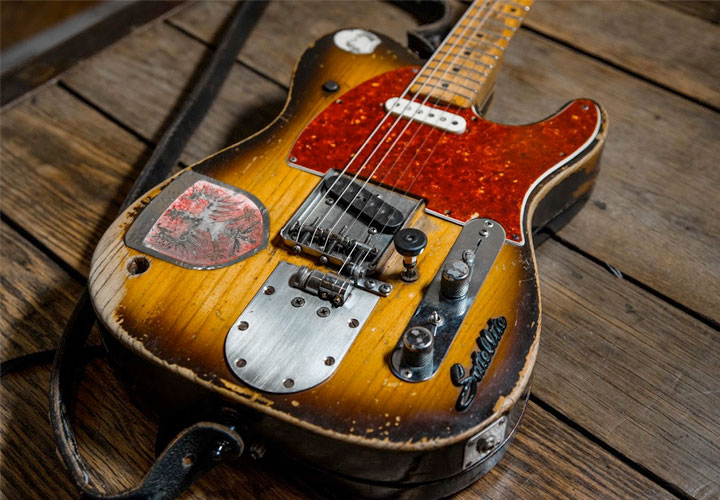This is a great story from the history of modern American country music. It’s the story of Clarence White and how he created the StringBender Telecaster.
The guitar mod “StringBender” Telecaster is often overlooked when it comes to very special guitar modifications done to standard guitars to make them better for certain styles of music. Maybe people don’t even realize what they were hearing on those later Byrd’s records was made possible by a mechanical guitar hack. Maybe it’s because Clarence White died young (hit by a drunk driver at age 29) or that The Byrds never quite reached superstardom.
But the original mod, conceived by White and fabricated by bandmate Gene Parsons, changed the way generations of players would think of the guitar. Unlike a slowly scooping blues bend that milks all the semitones in between two notes, the immediate and precise whole-step bends enabled by the Parsons/White StringBender device – sometimes called a B-Bender or pull-string – provided a pedal steel-like sound.

Clarence White’s StringBender (B-Bender) Telecaster
If you don’t know who Clarence White is here’s a little background…
Clarence White (born Clarence Joseph LeBlanc; June 7, 1944 – July 15, 1973), was an American bluegrass and country guitarist and singer. He is best known as a member of the bluegrass ensemble the Kentucky Colonels and the rock band the Byrds, as well as for being a pioneer of the musical genre of country rock during the late 1960s.
His best known work was as a session guitarist on the Byrd’s classic album “Sweet Heart of the Rodeo” that came out in 1968 at the height of the Byrd’s fame. It was a time when the band was moving away from folk rock style to more of a country rock style, as influenced by the Roger McGuinn and more importantly, Gram Parsons. The Country Rock sound was exploding in California due to the success of the Eagles, Jackson Browne, Moby Grape, and other west coast country rock bands.
Clarence got to California when his family moved there from New Brunswick, Canada. His family was already well-known in country music and the family band, The Kentucky Colonels were already established as a traditional bluegrass band on the west coast.
Clarence was playing at an LA bluegrass club called Nashville West around that time. He began to do session work and developed a name for himself.
As 1965 turned into 1966, White met Gene Parsons and Gib Guilbeau at a recording session for the Gosdin Brothers and shortly after, he began to perform live with the duo in local California clubs, as well as doing regular session work on their records, which were released under the moniker of Cajun Gib and Gene. 1966 also saw White begin playing with a country group called Trio, which featured drummer Bart Haney and former Kentucky Colonel, Roger Bush, on bass. In autumn of that year, as a result of his friendship with Gilbeau, Parsons and the Gosdin Brothers, White was asked to provide lead guitar to ex-Byrd Gene Clark‘s debut solo album, Gene Clark with the Gosdin Brothers. White briefly joined Clark’s touring band shortly thereafter.
The StringBender
During 1967, while they were both members of Nashville West, White and Gene Parsons invented a device that enabled Clarence to simulate the sound of a pedal steel guitar on his 1954 Fender Telecaster. The need for such a device was driven by White’s desire to bend his guitar’s B-string up a full tone, while keeping his left hand on the strings and fretboard. In order to achieve this feat, White felt that he needed a third hand. The guitarist turned to his friend Parsons, who was an amateur machinist, and asked him to design and build an apparatus to pull or drop the B-string.
Gene Parsons Explains How The StringBender Was Created
The device, which was known as the Parsons/White StringBender (also known as the B-Bender), was a spring-lever mechanism built into the inside of White’s guitar, which linked to the guitar’s strap button and the B-string. When it was activated, by pulling down on the guitar neck, it pulled on the B-string and caused the guitar to simulate the “crying” sound of a pedal steel. White would go on to use the device extensively as a member of the Byrds and, as a result, the distinctive sound of the StringBender would become a defining characteristic of that band’s music during White’s tenure with the group.
The Byrds Years
Following the abrupt departure from the Byrds of singer and guitarist Gram Parsons in July 1968, White was invited to join the group as a full-time member, remaining until the band was finally dissolved by lead guitarist Roger McGuinn in February 1973. This extended tenure with the band makes White the second longest-serving member of the Byrds after McGuinn. White was brought into the group at bass player Chris Hillman’s suggestion, as someone who could handle the band’s older rock material and their newer country-flavored repertoire.
The White-era version of the Byrds, featuring McGuinn, White and Gene Parsons, along with bassists John York (September 1968–September 1969) and Skip Battin (September 1969–February 1973), released five albums and toured relentlessly between 1969 and 1972. Journalist Steve Leggett has noted that, although the original line-up of the Byrds gets the most attention and praise, the latter-day version, featuring McGuinn and White’s dual lead guitar work, was regarded by critics and audiences as much more accomplished in concert than any previous configuration of the band had been. Byrds’ archival release Live at the Fillmore – February 1969 is oten cited as a good example of the White-era band’s musical potency.
The Byrds Play Dylan’s “Down In The Easy Chair” on Playboy After Dark
A Video Retrospective of Clarence White Through The Years
This includes scenes of him on The Andy Griffith Show with his bluegrass band and various perfomances with the Byrds and his other bands playing the StringBender. There is also an interview with Gene Parsons on how he concieved the StringBender.
Albert Lee Demonstrates A New B-Bender
The Byrds and Beyond
Despite being on tour or in the recording studio with the Byrds for the majority of the time between 1969 and 1972, White continued to undertake selected session work for other recording artists. During this period he played on Joe Cocker‘s 1969 album Joe Cocker!, Randy Newman‘s 1970 album 12 Songs, and the Everly Brothers‘ Stories We Could Tell from 1972. In early 1971, White also contributed guitar to Paul Siebel‘s Jack-Knife Gypsy album and the title track of the L.A. Getaway album by Joel Scott-Hill, John Barbata and Chris Ethridge. Other albums that White contributed his guitar playing to while he was a member of the Byrds include Linda Ronstadt‘s Hand Sown … Home Grown (1969), Rita Coolidge‘s Rita Coolidge (1971), Marc Benno‘s Minnows (1971), Jackson Browne‘s Jackson Browne (1972), Gene Clark’s Roadmaster (1973), and a trio of Arlo Guthrie albums: Running Down the Road (1969), Washington County (1970) and Hobo’s Lullaby (1972).
Clarence’s Early Death
White died on July 15, 1973, at the age of 29, after being struck by a drunk driver. The accident occurred shortly after 2 a.m., while he and his brother Roland were loading equipment into their car in Palmdale, California, following a White Brothers concert. Especially shaken by his death was Gram Parsons, who would lead a singalong of “Farther Along” at the funeral service and conceive his final song before his own death, “In My Hour of Darkness”, as a partial tribute to White.
Marty Stuart Acquires Clarence White’s Original StringBender


